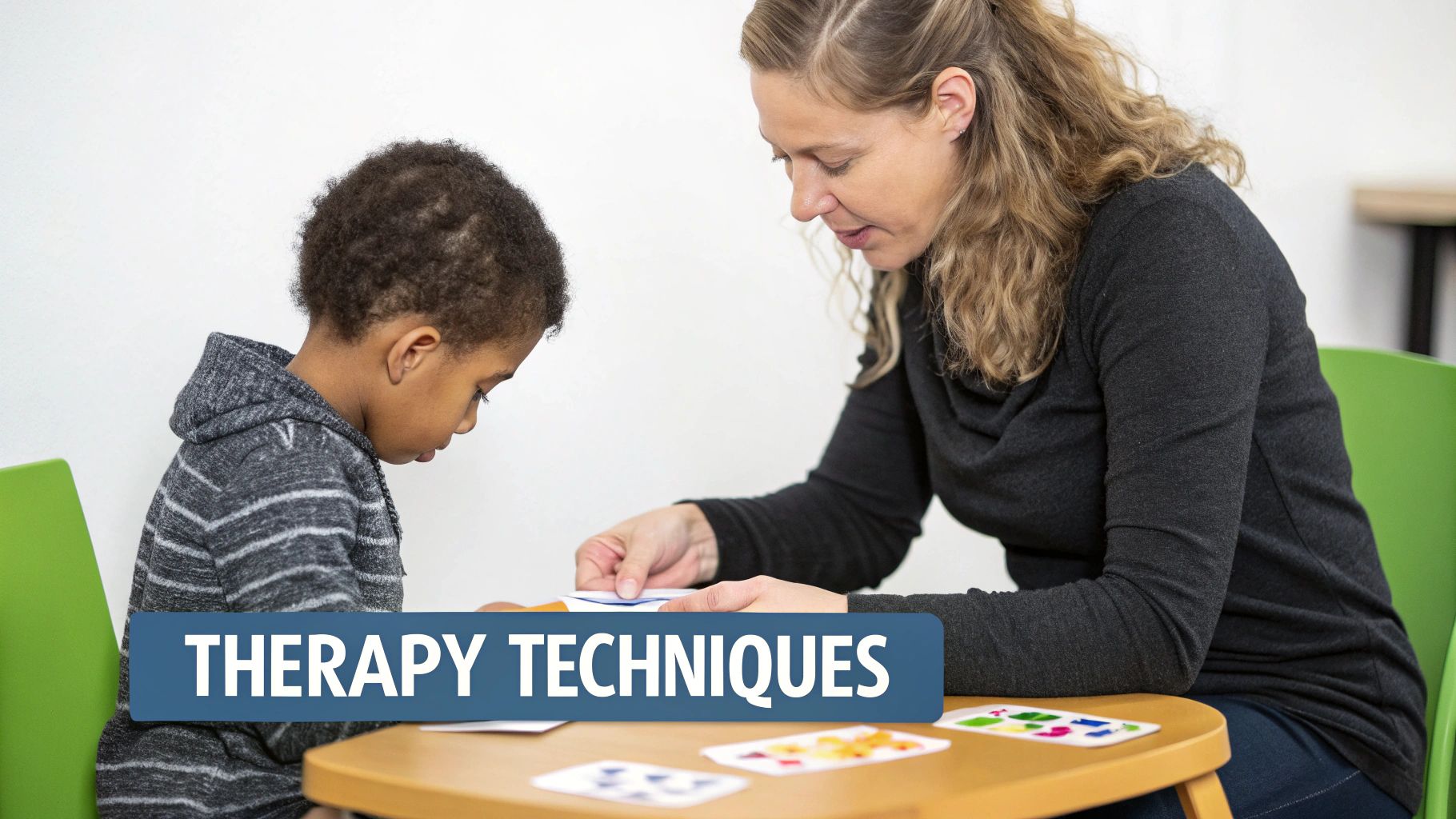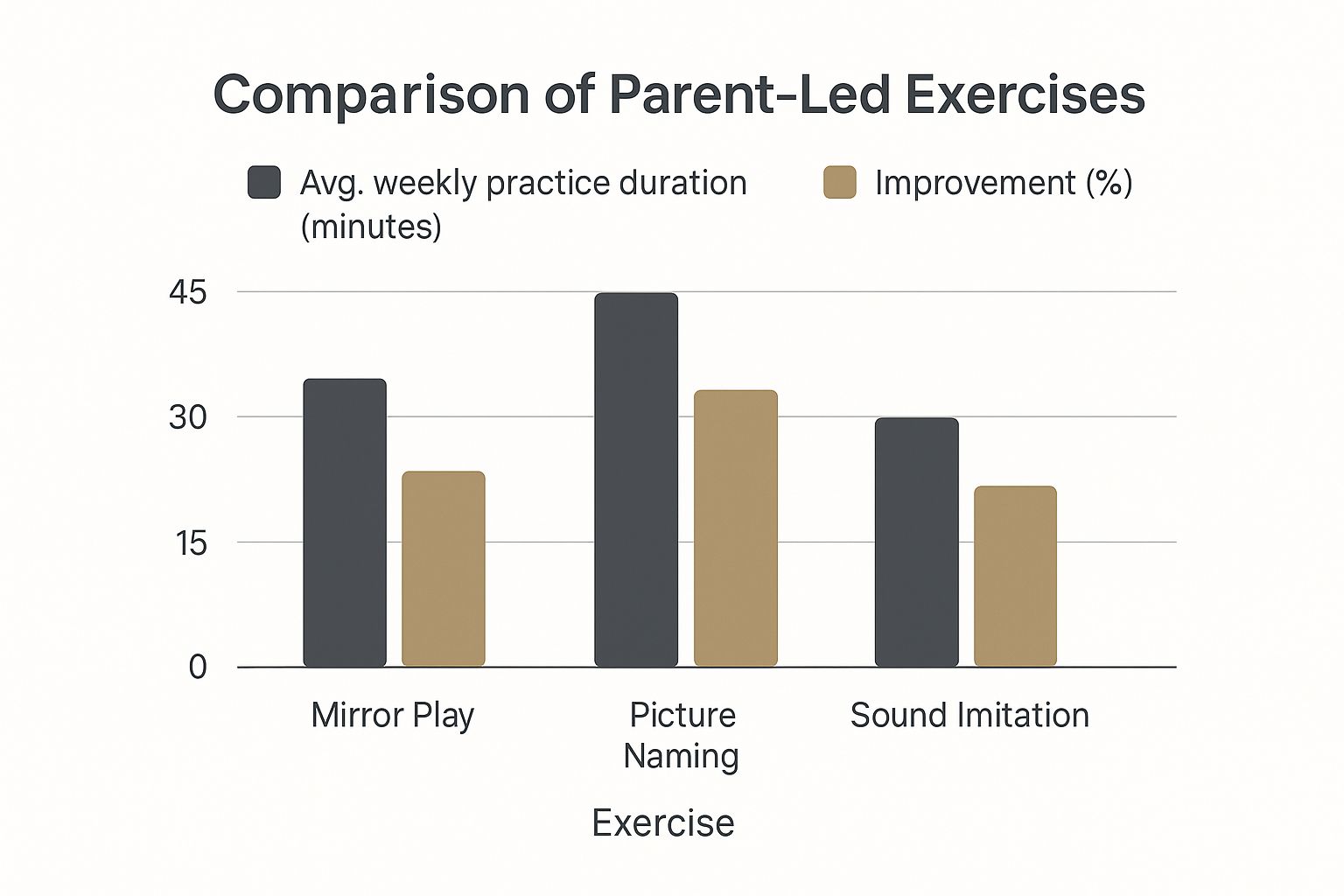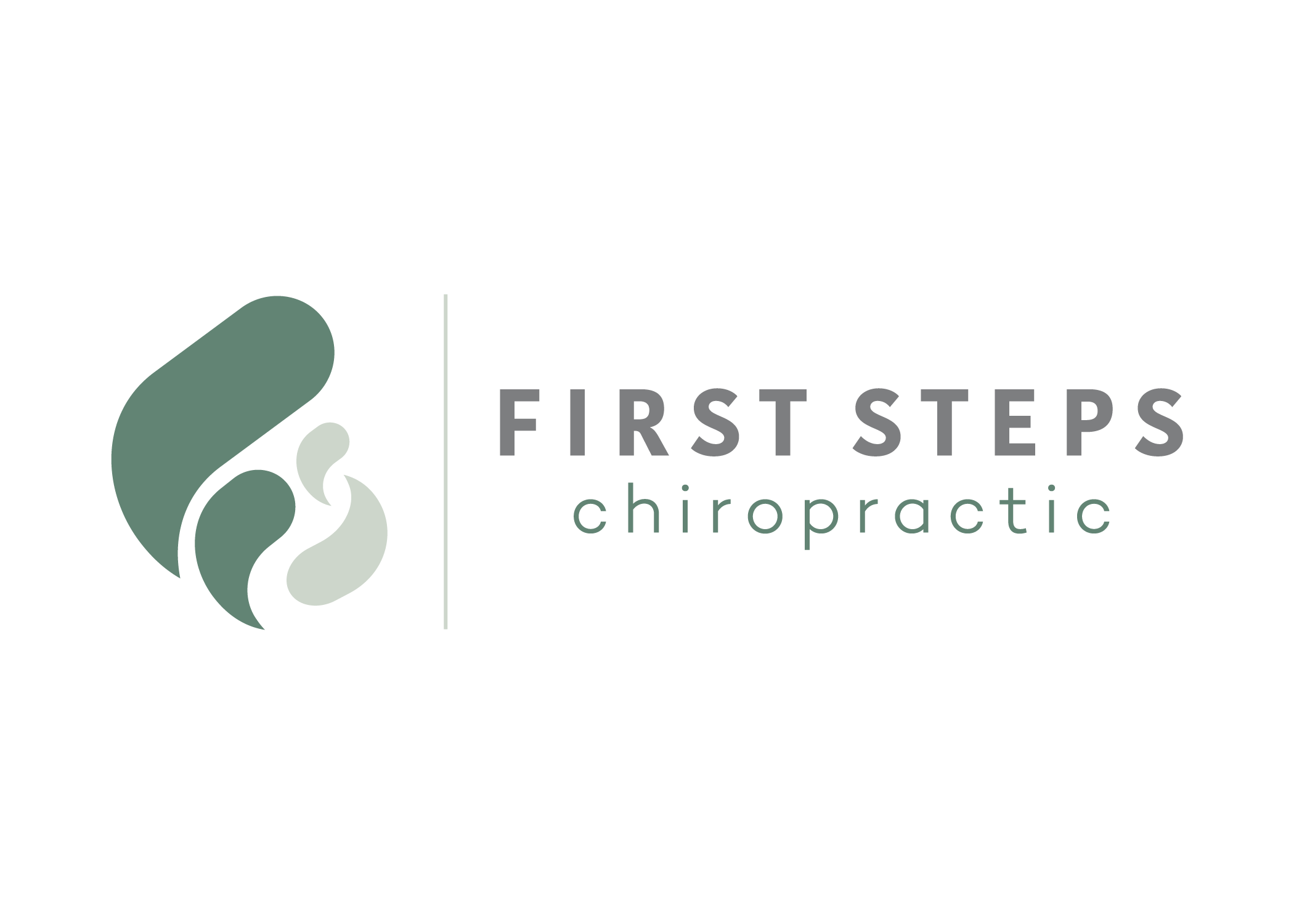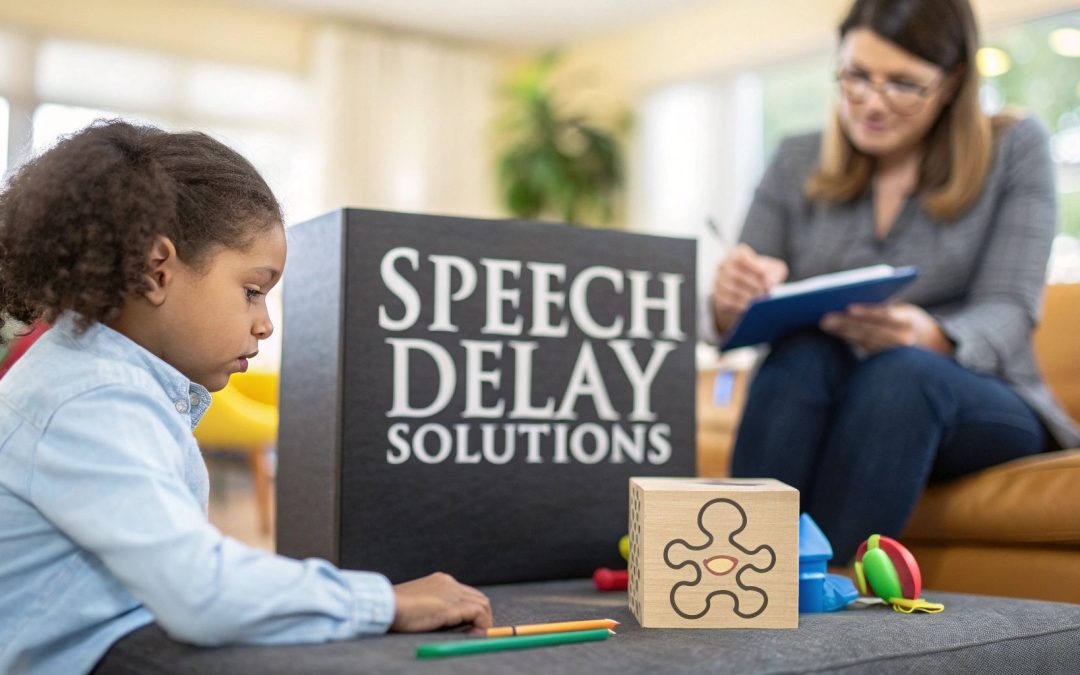Figuring out how to approach speech delay treatment can feel like you’ve been handed a map to a place you've never been. It’s natural to feel a little lost. But every journey starts with a single step, and this one is a team effort—a collaboration between therapists, your family, and your child, all working together to help them find their voice.
Your Journey Through Speech Delay Treatment

Starting the process to support your child's communication can feel overwhelming, but you are absolutely not in this alone. Think of this guide as your roadmap. We're going to break down what a speech delay really means for your child and family in simple, compassionate terms, moving past the clinical jargon to focus on the path ahead.
This is your high-level overview of the entire journey. We'll cover everything from the initial evaluations to the different kinds of therapies available and, most importantly, the crucial role you play in all of it. Our goal is to empower you with the knowledge and confidence to take those important first steps.
Understanding the Landscape of Speech Delay
So, what exactly is a speech delay? It specifically refers to a child’s trouble producing the sounds and words expected for their age. It’s really about the mechanics of talking. This is different from a language delay, which is more about the challenges of understanding and using words to communicate ideas.
Speech and language disorders aren't uncommon. Here in the United States, about 8% of young children deal with some form of a speech or voice disorder, which is why getting help early is so important. You can dig deeper into speech therapy statistics and their impact from recent studies.
The most important thing to remember is that early, consistent intervention is the most effective path forward. A child's brain is incredibly adaptable in the early years, making this a critical window for building strong, lasting communication foundations.
The Path Forward: A Four-Step Overview
Treating a speech delay isn't a one-and-done fix. It's a structured process designed specifically for your child's unique needs. Understanding the stages can make the whole experience feel less intimidating and help you feel more prepared for what's coming.
Here’s a simplified breakdown of what the journey typically looks like:
- Step 1: Evaluation and Assessment: It all starts here. A professional, usually a speech-language pathologist (SLP), will conduct a comprehensive evaluation. They’ll use a combination of standardized tests, observation, and interviews with you to get a clear picture of your child's specific challenges.
- Step 2: Creating a Personalized Plan: Based on what they learn in the evaluation, the SLP develops a targeted treatment plan. This isn't a generic template; it's a roadmap with specific goals, like mastering certain sounds or improving oral-motor skills.
- Step 3: Implementing Therapeutic Interventions: This is the active treatment phase where the work really begins. It often includes traditional speech therapy, but can also involve complementary approaches like occupational therapy and even neuro-tonal chiropractic care to support the nervous system.
- Step 4: Empowering the Family: You are your child’s most important teacher and advocate. This step is all about giving you the tools and strategies to support speech development at home, making sure the progress from therapy sessions sticks and grows.
To make it even clearer, here’s a quick summary of the key components of a comprehensive treatment plan.
At-a-Glance Guide to Speech Delay Treatment
| Component | What It Involves | Primary Goal |
|---|---|---|
| Comprehensive Evaluation | Assessment by a speech-language pathologist (SLP) using tests, observation, and parent feedback. | To accurately diagnose the delay and identify specific areas of need. |
| Individualized Therapy Plan | The SLP creates a unique plan with measurable goals and milestones. | To provide a structured, targeted roadmap for therapy. |
| Therapeutic Interventions | Regular sessions with an SLP, OT, and/or neuro-tonal chiropractor. | To build foundational skills in sound production, motor control, and neurological function. |
| Home-Based Support | Parents and caregivers learn strategies to practice skills during daily routines. | To reinforce learning, promote generalization of skills, and accelerate progress. |
Ultimately, this multidisciplinary approach ensures that every aspect of your child's development is supported, creating a strong foundation for them to build their communication skills.
Uncovering the Root Causes of Speech Delay
Figuring out why your child might have a speech delay is the crucial first step toward getting them the right help. Think of it like being a detective for your child's health—the more clues you gather about the potential causes, the more productive your conversations with specialists will be.
Speech delay isn't a single, straightforward issue. It can stem from a wide range of factors. Some are fairly direct, related to the physical parts of speaking, while others are more deeply connected to the intricate wiring of the nervous system.
Common Physical and Developmental Factors
One of the very first things experts will check is your child's hearing. It makes sense, right? If a child can't hear words clearly, they'll naturally struggle to copy them. Even something as common as recurring ear infections can cause temporary hearing loss, muffling sounds just enough to make it hard to tell the difference between "ba" and "da."
Another key area is oral-motor issues. This is just a clinical term for challenges with the muscles in the mouth—the lips, tongue, and jaw. If these muscles lack strength or coordination, forming specific sounds becomes a real struggle.
Imagine trying to play the piano with fingers that won't move on their own. It's a similar situation for a child whose tongue or palate isn't functioning properly. A speech-language pathologist (SLP) will often focus their initial evaluation here. For a deeper dive into how specialists diagnose these issues, check out our guide on what is speech delay.
The Nervous System's Role in Communication
Beyond the physical mechanics, we have to look at the "control center" running the whole show: the nervous system. A child's ability to learn, adapt, and communicate is profoundly tied to how their nervous system is processing the world.
Sometimes, a child’s nervous system can get stuck in a state of stress, what’s often called the "fight or flight" response. This isn't just about feeling worried; it's a deep physiological state where the body is constantly on high alert, braced for danger.
A child's nervous system is like a car engine. For optimal performance—learning, growing, communicating—it needs to run smoothly. If the engine is constantly revved up in high gear (stuck in 'fight or flight'), it can't efficiently handle tasks like processing language or coordinating speech.
This constant high-alert state creates what we call neurological tension. It essentially acts like a roadblock on the developmental highway, making it much harder for a child to relax, focus, and take in the information needed to learn new skills like talking. This state can be triggered by many things, including birth trauma, illnesses, or sensory overload.
How Neurological Tension Creates Roadblocks
When a child is stuck in this heightened neurological state, their brain automatically prioritizes survival over higher-level functions like developing language. It's just too busy scanning for threats to concentrate on learning new words.
This creates a few specific challenges:
- Difficulty with Regulation: The child may find it hard to calm down, pay attention, or engage in the simple back-and-forth interactions that are so essential for learning to talk.
- Impaired Motor Control: That internal tension can affect the fine motor skills needed for clear articulation, making the physical act of speaking more difficult.
- Sensory Overload: A stressed nervous system can easily become overwhelmed by everyday sights and sounds, causing the child to withdraw from the exact social situations where they would normally practice speaking.
Understanding this piece of the puzzle is so important. It shows us that addressing a speech delay often requires more than just practicing sounds. It's also about calming the underlying neurological state to create an organized internal environment where a child can finally relax, thrive, and find their voice.
Navigating the Professional Evaluation Process

The idea of a professional evaluation can feel a little intimidating, but it’s really just a positive, collaborative first step. This isn't a test your child can pass or fail. Instead, think of it as a team of specialists gathering the pieces of a puzzle to see the whole picture of your child’s unique communication style, strengths, and challenges.
This whole process is designed to be thorough yet gentle, giving everyone the clarity needed to build a plan for the treatment of speech delay that actually works. It's your chance to share what you've been seeing and ask all your questions, making sure you feel confident and ready to be your child’s best advocate from day one.
Who Is on Your Evaluation Team
Your journey usually starts with your pediatrician, who will likely refer you to a team of specialists. Each of these professionals brings a different perspective to the table, helping to create a complete and accurate understanding of your child’s needs.
Your team might include:
- Speech-Language Pathologist (SLP): This is your communication expert. The SLP will look at how your child understands language, expresses their thoughts, and forms sounds.
- Audiologist: An audiologist specializes in hearing. Their job is to rule out any hearing issues that could be getting in the way of speech development—a crucial and often-overlooked first step.
- Developmental Pediatrician: This doctor has extra training in developmental and behavioral challenges. They look at the big picture, connecting the dots between all aspects of your child’s development.
These pros work together, sharing what they find to make sure nothing gets missed. This team approach is what builds the foundation for a truly well-rounded and effective treatment plan.
What Happens During the Assessment
An evaluation is so much more than just a formal test. It’s a dynamic process that combines different methods to gather information in a natural way. The goal is to see your child in various situations to understand not just what they can say, but how they communicate overall.
The assessment usually involves a mix of these elements:
- Parent Interview: You know your child better than anyone. The process kicks off with a detailed chat about your child’s developmental history, your specific worries, and the strengths you see every day.
- Play-Based Observation: For young kids, play is their natural language. The SLP will join your child in both structured and unstructured play, watching how they communicate, solve problems, and interact.
- Standardized Testing: These are more formal assessments that compare your child's skills to those of other kids their age. This gives objective data that helps pinpoint specific areas of difficulty.
Professionals aren't just looking for a score on a test. They're observing your child's frustration tolerance, non-verbal cues, attention span, and willingness to engage. This holistic view is essential for creating a truly personalized plan.
Some evaluations may also look deeper into the underlying systems that support development. For instance, certain practitioners use specialized tools to get a window into how a child's nervous system is functioning. You can learn more about how Insight Scans reveal nervous system activity and how it connects to developmental milestones.
Preparing for Your Appointment
Feeling prepared can make the evaluation process go a lot smoother for both you and your child. A little prep work helps the specialists get the most accurate information possible, which leads to a better diagnosis and treatment plan.
Here are a few tips to help you get ready:
- Jot Down Your Concerns: Before you go, make a list of specific examples. Note words they struggle with or situations where communication seems to break down.
- Gather Key Documents: Bring any relevant medical records, reports from previous evaluations, or notes from teachers. This background info is incredibly valuable.
- Bring Comfort Items: A favorite toy or snack can help your child feel more relaxed in a new space, allowing their true personality and abilities to shine through.
- Prepare Your Questions: Don’t be afraid to ask anything! Write down what you want to know about the process, potential outcomes, or the next steps in the treatment of speech delay.
This evaluation is the starting line of a supportive journey. It's all about gathering information, building your team, and taking that first confident step toward helping your child find their voice.
Exploring Core Therapeutic Treatments
Once a professional evaluation gives you a clear picture of your child’s needs, the next step is diving into the “how” of treatment. This is where a team of dedicated therapists comes in, using specialized techniques to build a solid foundation for communication. The main goal isn't just to work on speech sounds in isolation; it's about creating a supportive, multi-faceted approach where different therapies come together to support the whole child.
The cornerstone of any effective treatment of speech delay is, without a doubt, speech therapy. This is led by a certified Speech-Language Pathologist (SLP), and it’s so much more than just practicing words. It’s a dynamic process designed to make communication fun, engaging, and genuinely rewarding for your child.
Inside a Speech Therapy Session
Imagine a therapy session not as a stuffy, clinical appointment, but as guided playtime with a very specific purpose. SLPs are masters at weaving therapeutic goals into the games and activities that children already love. This play-based strategy is incredibly effective because it takes the pressure off and cranks up the motivation, making learning feel almost effortless.
During a session, an SLP might focus on a few key areas:
- Articulation Skills: This is all about teaching a child how to physically make specific sounds. If a child struggles with the 'k' sound, the therapist might use a mirror to show them how their tongue moves to the back of their mouth, turning it into a fun game of "copycat."
- Language Development: This goes beyond just sounds and focuses on understanding and using words. An SLP might use picture books to build vocabulary or play with a toy farm to practice stringing words together in simple sentences, like "cow eats grass."
- Oral-Motor Exercises: Sometimes, the muscles of the mouth, tongue, and jaw just need a good workout. An SLP may use fun activities like blowing bubbles or sipping thick smoothies through a straw to strengthen these muscles and improve coordination for speech.
A key philosophy in modern speech therapy is child-led learning. Instead of rigidly directing every single activity, the therapist often follows the child's own interests, embedding language opportunities right into the play they choose. This empowers the child, making them an active participant in their own progress.
Complementary Therapies for a Well-Rounded Approach
While speech therapy is central, it rarely works in a vacuum. It’s often most powerful when it’s part of a team effort. Other therapies can address underlying challenges that might be contributing to the speech delay, creating a much more robust support system for your child. Two of the most common and effective partners on this journey are occupational therapy and play therapy.
Think of it like building a house. Speech therapy is like framing the walls and putting on the roof—it's the direct structure of communication. But complementary therapies are like pouring a solid foundation and wiring the electricity, ensuring everything else has the support it needs to function properly.
Occupational Therapy Supporting Sensory and Motor Skills
Occupational Therapy (OT) helps children better process sensory information and improve the fine motor skills they need for everyday life. For a child with a speech delay, OT can be a game-changer, especially if there are sensory processing challenges or motor planning difficulties getting in the way.
An OT might help a child who gets easily overwhelmed by loud noises learn calming strategies. They may also work on strengthening hand and finger muscles through activities like playing with clay, which indirectly supports the fine motor control needed for clear speech. By helping a child's nervous system become more organized and regulated, OT creates a calmer internal state where learning language is much, much easier.
Play Therapy The Natural Language of Children
Play therapy operates on a simple but powerful truth: play is how children communicate their feelings, process their experiences, and learn about the world around them. A trained play therapist uses this natural language to help children work through emotional or behavioral roadblocks that might be impacting their ability to communicate with words.
For instance, a child who is anxious and withdrawn might use puppets during a play therapy session to express feelings they can’t yet put into words. By creating a safe space for this kind of non-verbal expression, the therapist helps build the child's confidence and emotional regulation—both of which are foundational for verbal communication.
Below is a table that breaks down how these key therapies fit together, each with its unique focus and set of tools.
Comparing Key Therapeutic Interventions
| Therapy Type | Primary Focus | Common Techniques and Activities |
|---|---|---|
| Speech Therapy | Developing clear articulation, expanding vocabulary, and improving language comprehension and use. | Articulation drills through games, story-telling with picture books, oral-motor exercises (blowing bubbles), and guided play. |
| Occupational Therapy | Improving sensory processing, fine/gross motor skills, and self-regulation to support learning. | Sensory integration activities (swinging, tactile bins), fine motor tasks (puzzles, clay), and self-care routines. |
| Play Therapy | Addressing emotional and behavioral challenges that hinder communication and social interaction. | Using toys, puppets, and art to express feelings, role-playing social scenarios, and building confidence in a safe space. |
Each therapy brings a vital piece to the puzzle. By addressing the child from multiple angles—speech mechanics, sensory regulation, and emotional well-being—this collaborative approach offers the most comprehensive support possible.
The chart below shows how different parent-led exercises, often recommended by therapists, can impact a child's progress.

This data really drives home the point that consistent, focused practice like sound imitation leads to significant improvement. It reinforces just how valuable it is to integrate therapeutic strategies at home. By combining the expertise of SLPs, OTs, and other specialists, you create a powerful, unified front to support every single aspect of your child's developmental journey.
How Neuro-Tonal Chiropractic Supports Development

While therapies like speech and OT are essential for targeting specific skills, there's another piece to the puzzle. We need to create the best possible internal environment for those new skills to actually stick and flourish.
This is exactly where neuro-tonal chiropractic care comes into the picture. It’s a unique approach focused on strengthening a child's foundational health, which can make every other part of the treatment of speech delay that much more effective.
The focus isn’t on "fixing" speech itself. Instead, it’s all about the neuro-tonal system—the incredible communication network connecting the brain and the body. This system runs the show, controlling everything from breathing and digestion to learning and, you guessed it, speaking. When this system is running smoothly, a child can adapt, grow, and pick up new skills just as they're meant to.
Your Child's Nervous System: A Superhighway for Communication
Let’s try an analogy. Picture your child’s nervous system as a massive highway system, with the brain acting as the main traffic control center. Every single second, billions of messages are zipping along these highways, coordinating everything a child does. For speech to happen, countless signals have to travel lightning-fast and without a hitch between the brain and all the tiny muscles in the mouth, tongue, and jaw.
But what happens if there’s a huge traffic jam on that highway?
Stressors—whether physical, chemical, or emotional—can create these roadblocks. Things like a difficult birth, chronic ear infections, or even tumbles and falls can throw up major detours. In chiropractic, we call these roadblocks subluxations. They're specific areas of interference and tension gumming up the works of the nervous system.
When the nervous system gets stuck in a state of stress, it's like trying to learn a new song while a fire alarm is blaring. The whole system is too busy dealing with the "threat" to focus on higher-level skills like developing language. Neuro-tonal chiropractic helps to gently turn down that alarm.
These subluxations can lock the nervous system into a "fight or flight" response. Living in this constant state of high alert makes it nearly impossible for a child to relax, focus, and learn. That traffic jam slows everything down, including the crucial developmental signals needed for speech.
Gently Clearing the Roadblocks
The entire goal of pediatric neuro-tonal chiropractic is to find those tension points and gently release them, clearing the traffic jams. This isn't about the forceful "cracking" or "popping" you might imagine. Pediatric adjustments are incredibly gentle—we often use no more pressure than you’d use to check if a tomato is ripe.
Using these specific, low-force techniques, a pediatric chiropractor helps ease the tension stored in the nervous system. This helps the body finally shift out of that wound-up "fight or flight" state and move into a calm "rest and digest" mode. That’s the state where real healing, growth, and development happen.
When this shift occurs, the benefits can be profound:
- Better Regulation: A calmer nervous system means a child can better manage their emotions and attention, which makes them far more available for learning.
- Improved Motor Skills: Releasing that pent-up physical tension can improve the fine motor control needed to form words clearly.
- Enhanced Sensory Processing: An organized nervous system can process sensory information from the world without getting so easily overwhelmed.
Building a Stronger Foundation for Other Therapies
It’s so important to see neuro-tonal chiropractic care not as a replacement for speech therapy, but as its partner. It’s a complementary approach that works to create a healthier, more organized internal state for your child.
Think of it this way: when a child's nervous system is balanced and firing on all cylinders, they are far better equipped to absorb and integrate what they learn in their speech and occupational therapy sessions.
By addressing the underlying neurological tone, we help build a stronger foundation for all the other amazing therapies to build upon. This is a core idea in functional neurology, which is all about improving how the brain and body talk to each other. You can dive deeper into how a chiropractor supports this vital connection through functional neurology chiropractic techniques.
Ultimately, our goal is to help your child's body work more efficiently, creating the absolute best conditions for their speech and language skills to finally emerge and thrive.
Practical Strategies to Support Speech at Home
As a parent, you are your child's first and most important teacher. While professional therapy is essential for tackling a speech delay head-on, the small, consistent things you do at home every single day create the foundation where those new skills can truly take root and grow. Your job isn't to become a therapist overnight, but to be an engaged, responsive partner in your child's communication journey.
Think of your daily routines as powerful, built-in opportunities for language learning. Mealtimes, bath time, and even the simple act of getting dressed are perfect moments to model language. Small, intentional shifts in how you interact can make a world of difference, turning these everyday moments into teaching tools.
Weave Language into Daily Life
The single best thing you can do is become the narrator of your child's world. Talk about what you're doing, what you see, and what you're feeling. Use simple, clear language. This constant stream of words provides a rich model for your child to soak in, long before they're ready to use those words themselves.
Focus on describing objects and actions as they’re happening. For instance, during bath time, you could say, "Look at the yellow duck! The duck is floating on the water." This connects words directly to real-life experiences, helping build your child's vocabulary and understanding in a natural, completely low-pressure way.
Your goal isn't to quiz your child, but to immerse them in language. By modeling without any expectation of a response, you create a safe space for them to listen, process, and eventually try out new sounds and words on their own.
Make Playtime a Language Lab
Play is how children learn, and it's the ideal setting for practicing communication. Get down on the floor with your child and, most importantly, follow their lead. Letting their interests guide the interaction is the secret to keeping them motivated and engaged.
Here are a few simple but incredibly effective techniques to try during playtime:
- Offer Choices: Instead of asking an open-ended question like, "What do you want?" hold up two toys. Ask, "Do you want the car or the ball?" This provides a clear model and gives them a simple way to respond, even if it's just by pointing at first.
- Use Sound Effects: Make playtime noisy! Exaggerated sounds like "vroom" for a car or "moo" for a cow are often much easier for children to imitate than full words. Think of these fun sounds as a bridge to verbal communication.
- Practice Pausing: This one is huge. After you say something, just wait. Count to five or ten in your head. This "expectant pause" gives your child the time they need to process what you said and try to form a response. It also sends a powerful message: "I'm listening, and what you have to say is important."
Common Questions About Speech Delay Treatment
When you first dive into the world of speech delay, it’s completely normal to feel like you have a million questions. Getting clear, straightforward answers is the first step toward feeling confident and empowered to help your child. Let's tackle some of the most common things parents ask.
Speech Delay vs. Language Delay
One of the first hurdles for many families is understanding the difference between a speech delay and a language delay. It’s easy to get them mixed up, but they refer to two distinct parts of communication.
Think of it like this:
-
Speech Delay: This is all about the physical act of talking—the mechanics of making sounds. A child might have trouble forming certain sounds or articulating words, which can make their speech difficult for others to understand. This is the "how" of talking.
-
Language Delay: This relates to understanding and using words to share ideas. It’s about building a vocabulary, putting words together to form sentences, and grasping what others are saying. This is the "what" of talking.
It’s possible for a child to have trouble with one, the other, or a mix of both. A speech-language pathologist (SLP) is the expert who can really dig in and figure out exactly what’s going on.
When Should I Be Concerned About My Child's Speech?
While it’s true that every child hits milestones on their own schedule, there are some general timelines that can serve as helpful guideposts. You might start to feel concerned if your little one isn't babbling by 8 months, using single words by 15 months, or putting two words together by age 2.
But here’s the most important rule of all: trust your gut. As a parent, you know your child best. If you have a feeling that something isn’t quite right with their communication, it’s always worth bringing it up with your pediatrician or seeking an evaluation. Getting answers early can make all the difference.
What's the Role of Screen Time?
This is a big one for modern parents. Does too much screen time cause speech delays? While screens themselves aren't the direct cause, they can get in the way of what children really need to learn language: real, back-and-forth human interaction.
Kids learn to talk through play, conversation, and shared experiences with the people who love them. When screen time takes the place of those crucial moments, children miss out on countless opportunities to practice communicating. Making a conscious effort to prioritize interactive play over passive screen viewing is one of the best things you can do to support their development.
At First Steps Chiropractic, we focus on creating a strong, stable neurological foundation so your child's body can function at its best. This helps all other therapies, like speech and OT, become even more effective. Learn how our gentle, neuro-tonal approach can support your child's journey by visiting us at https://firststepschiropractic.com.

